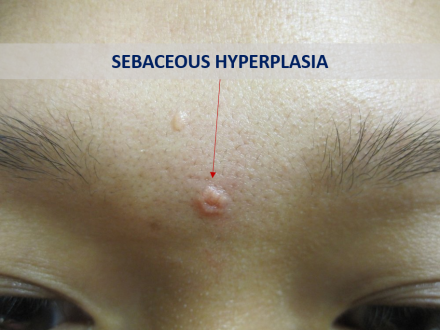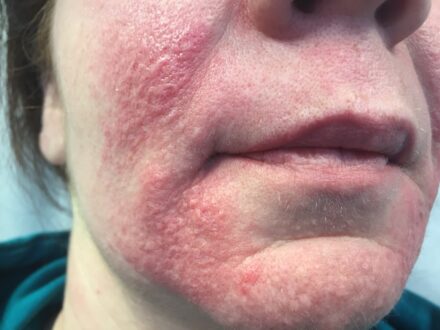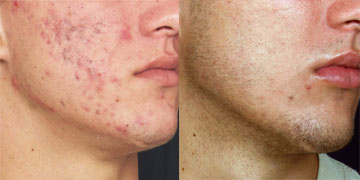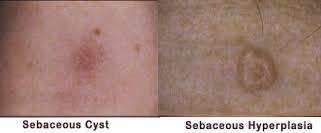Learn all about sebaceous glands, sebaceous glands hyperplasia, it causes various symptoms and all treatments. Sebaceous glands are found in the skin of mammals and these are the oil producing glands. Sometimes they get enlarged from their original size and cause various skin infections. Such as oily skin which leads to acne. As the bacterial infections occur and this causes the formation of pimples or skin lesions.
Acne is the one of the major skin infection and is caused due to the release of excess oil (sebum) from the sebaceous gland. This excess oil causes bacterial infections. Usually, those of 40 years age are more affected by this condition.
Sebaceous hyperplasia is caused by the exposure of sun also. As the skin of some people may get burnt by the exposure of sun this causes the sunburn and gives rise to the papules on skin. Generally, they are formed on the nose, cheeks, upper chest, shoulders where the sebaceous glands are present in large amount.
the lesion formed in this condition are due to enlargement of sebaceous glands. For some people, it may get triggered when the immune system is impaired due to any disease. As no pain is associated with sebaceous hyperplasia but persons with sebaceous gland hyperplasia should avoid the use of oily substances and should drink plenty of water.

Sebaceous Glands Hyperplasia Photos and Treatment
Sebaceous hyperplasia is a disorder of the sebaceous glands in which they become enlarged, producing yellow skinny bumps on the face. Sebaceous glands are located within the skin and are responsible for the secretion that lubricates the skin and protects it from drying. Sebaceous glands hyperplasia is generally found in newborns as well as in the people of middle age. Sebaceous glands hyperplasia causes 1-5mm papules on skin mainly on forehead, nose and cheeks and seborrheic facial skin.
What are Sebaceous Glands?
Sebaceous glands are microscopic exocrine glands in the skin that secrete an oily or waxy matter called sebum (Latin, fat). Sebum is the secretions that lubricates and waterproof the skin. They are found all over the skin except the palms of hand and soles of feet. They have acinar structure (like many lobed berries). Sebum secreted by sebaceous glands in humans is primaly composed of triglycerides (41%), wax esters (26%) squalene (12%) and free fatty acids (16%).
Sebaceous glands are part of the body’s integumentary system and serve to protect the body against germs.
They are of two types:
- Those connected to hair follicles; one or more glands surround hair follicle and glands themselves surround arrector Pilli muscle. They deposit sebum on hairs and bring it to the surface along the hair shaft. This structure consisting of hair, hair follicles, arrector Pilli muscles and sebaceous glands is an epidermal invigination known as the pilosebaceous unit.
- Those that exist independently; as in glabrous skin of eyelids, nose, penis, labia minora, the inner mucosal membrane of cheek and nipples.
Sebaceous glands in eyelids are known as meibomian glands.
Sebaceous glands in lips and membrane of cheeks are called Fordyce spots.
Sebaceous glands in the breast are known as Montgomery’s glands.
What is Hyperplasia?
Hyperplasia is an increase in the number of cells in an organ or tissue. This process is often harmless and sometimes beneficial.
Although the increase due to the formation and growth of new normal cells.
Hyperplasia is also of various types
- The benign prostatic hyperplasia.
- Cutaneous lymphoid hyperplasia
- Focal nodular hyperplasia
A Cutaneous lymphoid hyperplasia is a group of disorder such as accumulation of a large number of lymphocytes and histiocytes in skin. On other hand, focal nodular hyperplasia is an asymptomatic tumor of liver occurring chiefly in women. It is a firm nodular, highly vascular mass resembling cirrhosis, with a stellate fibrous core containing numerous small bile ducts and having vessels lined by kupffer cells.
Sebaceous Hyperplasia Symptoms
Sebaceous hyperplasia is indicative by the presence of soft yellow lesions on the face, cheeks, forehead and nose in adults. Sometimes these lesions may also develop on chest, mouth, vulva or penis. These lesions or tiny bump like structures are usually harmless.
The size of these whitish-yellow lesions varies from 3-10mm in diameter. Sometimes these lesions may contain a central depression through which pus-like liquid is discharged. There will not be any pain or swelling.
Other symptoms include:
- Acne
- Dryness of hairs
- Multiple or single lesion may appear
- Lesion may be popular and cauliflower-shaped
Sebaceous Hyperplasia Photos





Sebaceous Hyperplasia Treatment
Sebaceous hyperplasia treatment depends on the condition as it is benign and relatively harmless it not requires any treatment. But sometimes it may have to be treated as it leads to infection or inflammation because of chronic irritation.
Sometimes the lesions are blemishing covering a large area of skin in this case chemical treatments such as trichloroacetic acid are used.
Medication such retinoids are used. Retinoids reduce the size of lesions and they cause various side effects if they are used for a long time period. Using retinoids we can get rid of these lesions in two to six weeks but unfortunately when retinoid is stopped the lesions come back after a month.
Accutane is also used but lesions can come back after stopping the medication. Lesions can be removed by the dermatologist by different methods such as:
- Excision-cutting out the lesions
- Cautery or burning
- Radio surgery (in this treatment no blades or cutting material is used) The scalpel is replaced by using radio waves.
 Health & Care Information
Health & Care Information 

